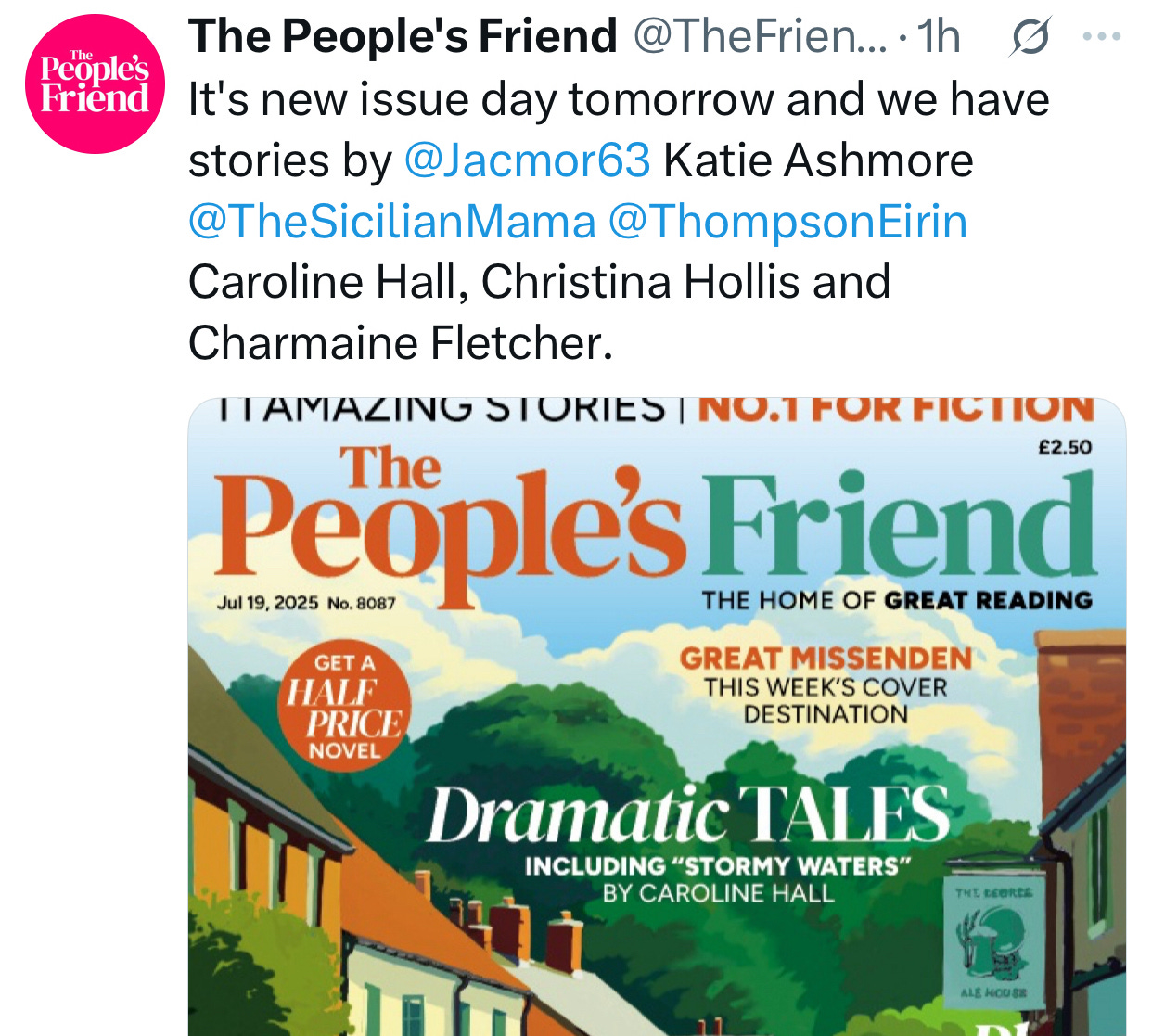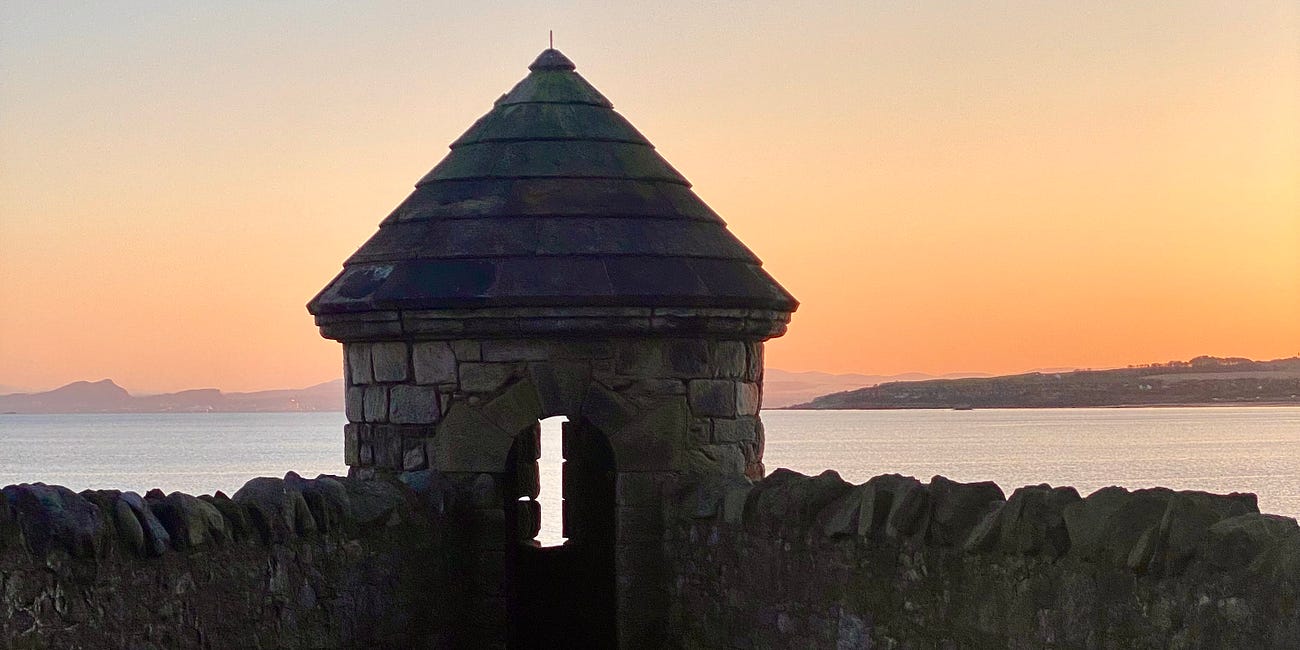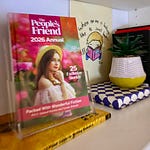I had a short story published in a UK Women’s magazine this week! My first ever historical story!
Photo: Courtesy of Levenmouth Pictures (copyright: Levenmouth Pictures): one of the photos that prompted my story! This is Kirkcaldy High Street of old!
When I first challenged myself to write a historical story for the magazine, I didn’t expect to be tracing the outline of my own family’s beginnings!
It started with the simple idea – the Meet-Cute of my parents in a factory in my hometown, and quickly grew into something quite magical and nostalgic.
It revealed again something I keep forgetting – my ordinary is extraordinary to someone else.
WHERE THE PAST BEGINS – THE SPARK
I decided to stretch myself to write something different and researched what others were doing in the women’s magazine market around historical stories. There were stories of biscuit factories, toffee factories, railways, etc. There were Dukes and Bridgerton type stories, there were maids and country mansions.
My own town, Kirkcaldy in Fife, Scotland, was and is famous for a certain product (linoleum) and the BBC made a TV programme about it called Flooring The World.
Could I write a story based in Kirkcaldy, featuring Nairn Flooring – the company who have produced floor cloth for over one hundred years and is now famous all over the world for its quality linoleum used in medical settings and schools, as well as homes? I wasn’t sure it was a very glamorous setting. Who wants to know about that?
Then I remembered…something that I always knew but didn’t think was particularly exciting to share…until I realised it was the stuff of a storyteller’s dreams!!! My parents Meet-Cute in the 1950s at work!
THE PROCESS
The ordinary story of my parents Meet-Cute was something instantly recognisable to many couples and families from the 1950s. Many people met in the work-place in the factories, becoming lifelong friends – or romantic partners.
I started researching the linoleum industry beyond the anecdotal tales I’d heard from my parents and others. I remembered being taken to see one of the factories being pulled down in the 70s/80s. There’s a street near there called Factory Road.
I settled on a time period around the time my parents met – the late 1950s and researched the popular music and cinema of the time. I imagined the ordinary fabric of lives in those days – thinking back to my gran and grandad’s house of the 70s and what it may have looked like in the 1950s.
I researched a lot about the life of the linoleum factory, Nairns, and rewatched a BBC documentary called The Town That Floored the World (See my notes at the end). However, I was aware I’d need to take care that research did not overshadow the story. There was a balance to reach in only including the detail that helped place the story, and the emotional responses feeling right for those times.
Author Philippa Gregory puts it like this:
“I research until I hear the characters talking to me, and then I stop.”
This is exactly what happened. The characters began to speak to me – their voices, their laughter, Barbara’s shyness hiding her growing confidence – and I knew it was time to simply get on and write the whole 3000 word story!
THE CHALLENGE
What I had was a Meet-Cute opportunity in a factory, but the challenge was to wind it around a believable family life, the sweetness of a new romance, whilst maintaining some cheekiness and feel-good in the environment of a factory-town - for it not to seem drab. It was anything but!
There was an emotional challenge for me to write a sympathetic main character whose current love-life was lack-lustre, yet to have her come across as worthy, more than worthy, of a proper love that was awaiting her if she’d just take the chance.
What surprised me as I was writing it, was how I looked afresh at life in 1950s Scotland: the rhythms of shift work; the noises and smell of the factory floor; where friendships were formed, and quiet flirtations bloomed. Everything began to shimmer with significance, and as I gave myself over to the storytelling flow, Kirkcaldy itself came alive in front of my eyes: prosperous years where people flocked from afar to a busy High Street.
My very first historical story surprised me greatly. Kirkcaldy isn’t just a place I live, it is a living archive with a rich social fabric that wove lives together in post-war Scotland.
WRITING HOME
I realised I was transfixed. I’d time-travelled back to the Kirkcaldy that my parents knew as they set out on their independent adult lives. Their meet-cute wasn’t remarkable like the movies, it was quiet, yet strong.
The male character, Paul, stakes his chances on the young, shy worker, even though he knows she is going to the movies with a rival – who turns out to be quite the cad!
The female character, Barbara, rather likes having a boyfriend but not one who doesn’t listen to her, or treasure her. When she locks eyes with the new guy in the factory, Paul, she immediately sees him as a lead movie character, as he too sees her – someone to treasure.
We also meet Barbara’s mum, and some co-workers are mentioned - enough to bring a real-life environment in which to tell the story.
Even during the first date at the movies, Barbara knows this is someone her parents will approve of and that Paul himself will be proud to tell his sisters and mum about his new girlfriend. There’s no more hiding Barbara! There’s a whole dollop of wholesome in this story. How could I not? It was the 1950s!
It’s a quiet romance. A quiet story. Yet, I like to think it transported readers during the time they read it.
WRITING THE ORDINARY INTO HISTORY
Somehow, I managed to relay the extraordinary in a small-town romance in 1950s Scotland in a way that my editor loved from the off. I was told it was likely a first for the magazine – a story set in Kirkcaldy. That made me glow with pride. I’d done it. I’d managed to use historical facts alongside a Meet-Cute and seamlessly bring them together into a story with an uplifting ending.
Not only that, I’d used several Connie Francis songs as they were in the charts at the time. I used those titles (and their meanings) to bookend my story…that is, give a shorthand meaning/clue at the beginning and then roll the whole story up with another song at the end. Those songs were: Stupid Cupid, and Who’s Sorry Now?!
Imagine my sadness to learn that Connie Francis died on the very day the magazine with my story landed on the shop shelves. That wasn’t the only thing that made me shed a tear.
SERENDIPITY
I was travelling home from a short holiday on the west coast of Scotland. Despite Mr.M starting chemo this week, he insisted on driving the motorhome while I kept up to date on my phone reading online. (We’re living every day to the max by the way!) Twitter/X, Tuesday 11am, is when The People’s Friend Hour takes place and writers chat with staff and each other. I try not to miss it.
That was when I learned I was going to be in print this week. You see, I don’t always know the date or edition that my story will appear in – and this story was one of those! So, we were then on a mission to get home to discover WHICH story of mine was in this week’s edition. My postal/submission copy was waiting on the doormat on 15th July.
15th of July was my mum’s birthday and my parents wedding anniversary. Mum died in recent years (and we lost dad years ago), so the date has taken on new significance. To say that I cried when I saw the illustration for the story! The story that fictionally described my mum’s anecdotal telling of their Meet-Cute – their meeting at the factory and date at the cinema. It’s beautiful and displays more than a passing resemblance to my mum in her dark, high ponytail and my dad with his blonde quiff.
Photo Jackie Morrison. Illustration by Ruth Blair for The People’s Friend magazine
USING SETTING IN STORY-WRITING
I’ve previously written a whole essay on this. What can I say….I have another story appearing very soon, also set in a fictional Kirkcaldy/Dysart inspired by the time Outlander was filmed at our harbours, the tall ship sailing out on the Forth. In fact, I only just heard today that it’s in the People’s Friend Special this month (out today: Wednesday)!
Here's the link to the previous Post on settings!
YOU'RE WRITING IN THE WRONG PLACE
Heartfelt thanks for subscribing and reading as I ramble my way from winter into spring in my little writing corner in Scotland.Thanks for reading Little Writing Corner! This post is public so feel free to share it.
My essays are free to share, so do go ahead and restack if you find anything useful! I’m always happy for any new folks to pop along to the Little Writing Corner and join us!
ENDINGS
Writing this historical story taught me that history doesn’t always arrive with fanfare. It needn’t be Kings and Queens or a national event. It can be two people meeting and falling in love. Sometimes it takes fiction to help us see places, and people, with fresh eyes.
If you’re considering writing your own historical tale – especially one rooted in memory or place, consider some prompts you might enjoy:
What small, real moment from your family history stays with you?
Is there a place you thought you knew – a town, a home, a workplace – that might reveal new layers through fiction?
What details might help bring that time period to life (clothing, food, music, smells – they are all in my story!)
Whose voices do you hear when you sit with that memory?
What part of the story feels quiet but emotionally true – how might you incorporate that whilst keeping it fictional?
BENEATH THE SURFACE
I hope I’ve demonstrated this week that historical fiction doesn’t have to start with royalty or a revolution. Sometimes it starts with a glance across the factory floor, a shared lunch break, or a walk home – and from there, the past begins to speak.
Are you currently writing historical fiction, or do you intend to try?
For now, thanks for being here with me in the Little Writing Corner in Scotland. Until next time, sending love and encouragement, from Jackie x x
Subscribing is free! If you’ve found this, or my other essays helpful, please consider a one-off donation Buy Me A Coffee, or supporting my work with a paid subscription. Thanks.
NOTES:
The documentary featuring Kirkcaldy: The Town That Floored The World: BBC
Phillipa Gregory’s books can be found in all bookshops and on Amazon: Phillipa Gregory















